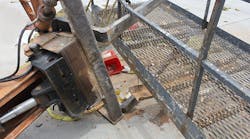Fatality Investigation: Oversized Scaffolding Platform Destabilizes and Telescopic Forklift Overturns
(The Kentucky Fatality Assessment and Control Evaluation (FACE) Program is tasked with investigating fatalities and making recommendations to ensure they do not occur again. This is one of their recent cases...)
An out-of-state roofing and sheet metal company had been hired as a sub-contractor to install insulation and siding on an aircraft hangar, which was nearing construction completion. Two siding subcontract installers stood on a 4 foot by 16 foot platform suspended 40 feet in the air, installing exterior insulation on the north wall of the hangar. The platform was secured to the forks of a rough terrain telescopic forklift truck.
The installers signaled for the foreman, who was operating the forklift, to lower the platform. The foreman tilted the frame of the platform in order to avoid scraping the wall of the building during the platform descent, and lost control of the lever handle. The tilt became more pronounced and the weight of the 40-foot extended platform caused the forklift to turn over onto its left side, slamming the platform onto the concrete ground below, killing a 23-year-old siding installer and injuring the second siding installer. EMS arrived, and the victim was pronounced dead at the scene while the second injured siding installer was airlifted to a major trauma center for treatment.
Misuse of Equipment
The equipment at the job site was a Lull model 844C rough-terrain telescopic forklift with a wheelbase width of 8 feet and a load capacity of 8000 pounds (Figure 2). The operator’s manual warned that this equipment only should be used for material handling, and should never be used to lift personnel. This forklift model was not factory equipped with stabilizers to prevent it from tipping over.
An Arrow brand man platform model 90WP48-192 was used as an attachment to the forks at the end of the forklift boom. This platform was constructed of steel and measured 4 feet by 16 feet, with 43-inch-high side walls spanning the length of the platform and no end walls (Figure 2B). The length of the platform considerably exceeded the wheelbase width. ANSI requirements specifically state to not use a platform that is wider than the wheelbase due to the risk of an overturn.
It appeared that alternative equipment was available on the site – a Skyjack SJ8243 Scissor Lift, which specifically is designed for the lifting of personnel (Figure 3) – and either was overlooked or rejected for unknown reasons. Located on the premises was.
Contributing Factors
This investigation by the Kentucky Fatality Assessment and Control Evaluation (FACE) Program identified the following factors that may have contributed to the fatality:
- The rough terrain forklift truck was not designed to lift personnel.
- The platform on the lift was too long, causing the forklift to become unstable.
- The operator tilted the lift while lowering the manned scaffold platform.
- The employee was not trained to operate the lift.
The group offered these recommendations for prevention:
- Employers should provide appropriate siding equipment on the job site and ensure all employees are trained to operate the siding equipment.
- When lift equipment is required to elevate siding installers, choose only equipment specifically designated by the manufacturer for that purpose, for example, scissor lifts and telescopic boom lifts specified for lifting personnel.
- Avoid tilting a forklift truck when the platform is elevated.
- When using a forklift approved by the manufacturer for personnel lifting, the width of a scaffolding platform should not exceed the width of the forklift wheelbase.
About the Author: De Anna McIntosh currently serves as the safety specialist for the Kentucky Fatality Assessment & Control Evaluation (FACE) Program in the Kentucky Injury Prevention and Research Center, where she routinely investigates and reports on occupational fatalities across the state of Kentucky. With a focus on prevention, her reports analyze a variety of contributing factors to each case, and subsequently make prevention recommendations centered on administrative controls, environmental controls, PPE use and existing safety regulations. McIntosh has an extensive background in occupational health and safety practice, most recently having served as an investigator for OSHA at the Kentucky state level. Prior to OSHA, she held the position of safety manager with several large companies including Pepsi-Cola.
Kentucky FACE, grant funded by NIOSH, uses the facts collected from detailed fatality investigations to formulate and disseminate strategies for injury prevention, with the hope of preventing future, similar incidents. The program, which does not determine fault or blame, operates from the Kentucky Injury Prevention and Research Center at the University of Kentucky.


